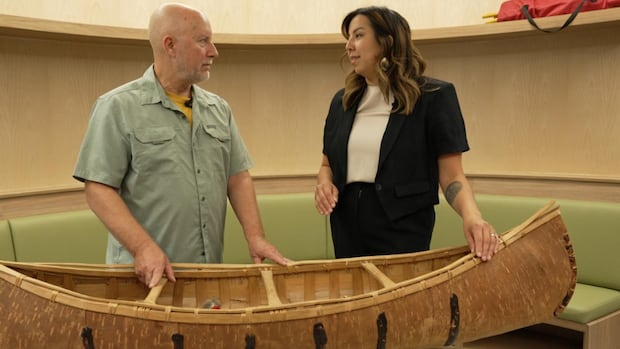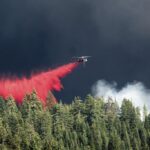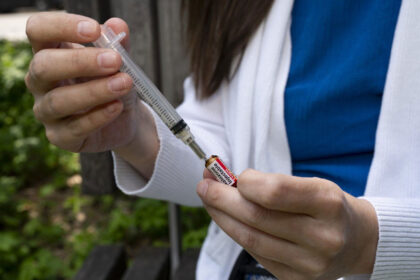SaskatoonCBC reporter Dan Zakreski tells the story of how his family came to own a two-metre-long handmade birchbark canoe.CBC reporter Dan Zakreski shares the 40-year journey of a handmade birchbark canoeDan Zakreski · CBC News · Posted: Sep 02, 2025 6:00 AM EDT | Last Updated: 2 hours agoKelley Cardinal, right, a superintendent of education with Greater Saskatoon Catholic Schools, says the birchbark canoe that was gifted in the 1970s to Dan Zakreski’s father will be a teaching tool at awâsisak kâ-nîmîhtocik–St. Francis School. (Don Somers/CBC)It was the early 1970s and my dad, Orest Zakreski, was the regional director of Indian and Northern Affairs for Saskatchewan. We lived in Regina and dad travelled around the province doing government business, often returning home with gifts from various First Nations. Our house on Hudson Drive featured a collection of beaded moccasins, pipes, jackets, mittens, tomahawks, sculptures, totem poles and ceremonial drums — and, a two-metre-long birchbark canoe.The canoe featured hand-carved wooden gunwales and yoke, thin-sliced strips of bark as binding and tree gum as sealant. Orest Zakreski spent time on First Nations across the province. (Submitted by the Zakreski family)A garage saleMy dad died suddenly of a heart attack in 1977 at the age of 48 while on a work trip to Saskatoon. My mom died of cancer five years later at 51. Suddenly, I and my three younger siblings and our dog Ernie found ourselves alone in a two-storey house in south Regina.We eventually decided to sell the big house and organized a garage sale to clear space. We were in our teens and early 20s, grieving — none of us with any real appreciation of the value of what we were selling. We had the canoe as part of the sale. That’s when my dad’s older sister, Victoria Gillies, intervened. Auntie Vickie, an artist, gardener and collector, lived in a sprawling bungalow in south Regina.She saw the artistic and cultural value of the canoe, buying it from us on the eve of the sale. It went into her basement, along with other items she rescued from the garage sale, where they remained for the next four decades. Victoria Gillies, an artist and collector, saved the canoe from a garage sale. (Submitted by the Gillies family)A family reunionEarlier this summer, my dad’s brother and sister-in-law, Wes and Sylvia Zakreski, were preparing to celebrate their 90th birthdays in Saskatoon. It was a big deal, as everyone in our family knew the chances to get together outside of funerals and weddings were dwindling, so parties were organized in town and at the farm near Alvena where my dad grew up.That weekend, Auntie Vickie’s daughters Laurie and Ellen showed up at my house — with the canoe wrapped in a blanket in the back of their car. Vickie had died in 2021 and my cousins wanted our family to have the keepsake their mom had rescued when we were kids.It was a wonderful, kind gesture and I moved the canoe into my basement. I had not seen it for decades and memories flooded back as the familiar birch scent filled the house. I had only one troubling thought: what would I do with a two-metre-long ceremonial birchbark canoe?Two days later, we celebrated my aunt and uncle’s birthday party with an afternoon come and go event. At the function, I was approached by my cousin Sharon Zakreski, a trustee with the Catholic school division in Saskatoon.”Did your dad used to have a birchbark canoe that a First Nation gave him?” she asked, out of the blue.I looked around for a hidden camera.”What — you mean the canoe that Laurie and Ellen brought up two days ago? The canoe I hadn’t seen in 40 years? That canoe?”Homeward boundSharon said that awâsisak kâ-nîmîhtocik–St. Francis School was opening in its new location in September and a superintendent wanted to know whether we’d donate the canoe to the Cree bilingual school, as a cultural artifact and teaching tool.I talked to my siblings and there were tears — and immediate agreement. On a warm morning in late August, I packed the canoe into my hatchback and drove it to St. Francis on Seventh Street East.Dan Zakreski loads the ceremonial birchbark canoe into his car. (Don Somers/CBC)Kelley Cardinal, a superintendent of education, met me inside the main doors and we walked the canoe to the Elders’ room.”It’s a beautiful testament to the innovation and skills that Indigenous people had,” she said.”I think it’s going to be an excellent teaching tool. Just looking at how it’s crafted and the time, the thought, all the love that was put into this canoe.”Cardinal laughed when I said that I didn’t get a chance to trace which First Nation gifted the canoe to my Dad, or under what circumstances. I suspected there was a registry of gifts given to senior bureaucrats in the 1970s tucked in some government file, but to get the file would require an access to information request and proof of the relationship with the deceased employee. Cardinal said the students could do the heavy lifting.”One of the first things I can think about is an inquiry project the students may be able to do,” she said.”I think it’s going to be a great learning journey for students to try and identify the whereabouts, where did this canoe come from, who made it and how you and your family came to receive it and where it should go from there.”Our canoe was going home.ABOUT THE AUTHORDan Zakreski is a reporter for CBC Saskatoon.
Birch and reconciliation: My First Nation canoe story











